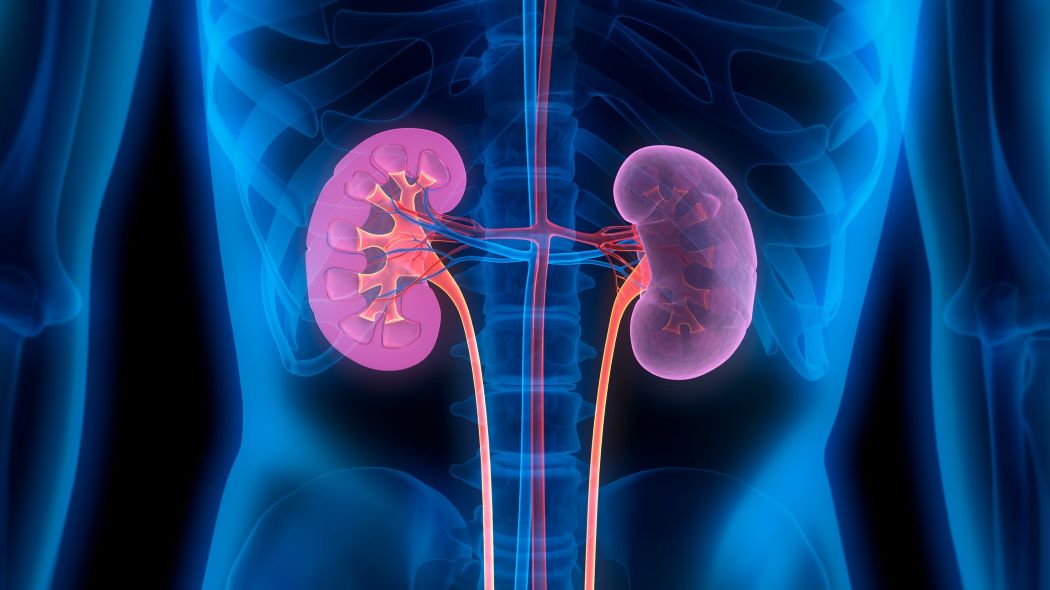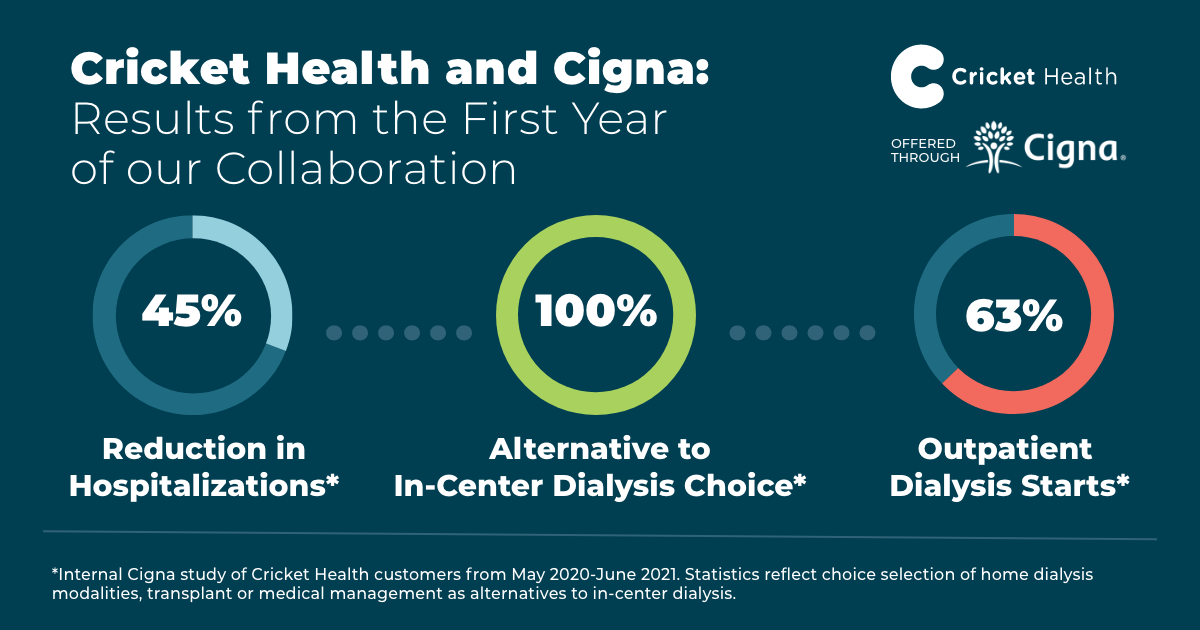
Highlights:
- Kidney disease is a silent disease, until it becomes advanced and symptomatic.
- We used to have limited treatment options, but we are starting to see new drugs come out that help slow down the progression of kidney disease.
- Early results from a Cigna + Cricket Health digital collaboration show more than a 45% reduction in hospitalizations for people living with kidney disease.
Kidney care in the U.S. is fundamentally broken. The status quo is not serving patients, or their providers.
According to the CDC, most people with kidney disease go undiagnosed. This leads to too many people advancing to kidney failure and life altering in-center dialysis, in addition to incredibly high medical costs and a poor patient experience.
To better understand kidney disease and what it will take to effectively serve patients who are living with this chronic condition, we interviewed Dr. Rajesh Davda, MD, MBA, a nephrologist and senior medical director at Cigna. Read on to learn about what kidney disease is, how its diagnosed and treated, as well as how Cigna is working to improve patient engagement and clinical outcomes for people living with this chronic disease.
What exactly is kidney disease, and what do people need to know about it?
Kidney disease is a gradual decline in kidney function. I divide kidney disease into three buckets: People who have kidney disease but are not on dialysis, patients who are on dialysis, and those who get kidney transplants.
Most people think that you need to do dialysis before opting for a kidney transplant. But that’s not really true. You just need to have advanced kidney disease. It’s also important to note that people don’t progress through kidney disease in a linear fashion. The major causes of kidney disease in the United States are diabetes and high blood pressure. Detecting people who have kidney disease has always been a challenge because you need to do both a blood and a urine test, and so it is an under-detected disease.
Talk to me about what Cigna is doing to support customers with kidney disease.
We’ve had the Cigna LifeSOURCE Kidney Transplant Network for a number of years, helping people to get access to transplants in a cost-effective manner with case management support, education and many different tools. Another major program we’ve had in place for over a decade is our Chronic Kidney Disease Case Management offering, which has been very effective and is available to all of our clients.
About five years ago, we rolled out a Cigna Collaborative Care program for chronic kidney disease, a value-based care model that uses incentives to engage health care providers and helps drive improved health, affordability, patient satisfaction, and provider experience. This program, which focuses on customers with kidney failure and end-stage renal disease requiring dialysis, is doing really well from both the quality of care customers receive and from an affordability standpoint. To date, the program has led to lower costs and fewer unneeded hospitalizations for customers with kidney disease. Our internal kidney disease case management programs help direct patients to in-network dialysis centers to help eliminate surprise billing for patients, reduce hospitalizations, and educate patients about kidney transplantation early.
Finally, we are now moving towards focusing more on customers living with pre-dialysis kidney disease. Our partnership with Cricket Health is an example of that.
Cricket Health works with Cigna participating network nephrologists and primary care physicians, providing education, support and personalized guidance to customers with kidney disease between doctor’s appointments. A single nephrologist may be providing care to 80 to 100 people on dialysis, which leaves a gap for people living with kidney disease who have not progressed to dialysis or those who need preventive care. Our collaboration with Cricket Health helps fill in that gap by providing more personalized and regular health care touchpoints through an interactive digital interface, and we are seeing an improvement in the quality of life for our customers with kidney disease.
Cricket Health uses data sets and machine learning for early identification of kidney disease and reaches out to Cigna customers enrolled in their platform for help with managing their chronic kidney disease. Cricket also works with our Cigna programs to help people get started with in-home dialysis and to get a transplant, if that is what the customer chooses. They can help reduce in-patient admissions and help the customer make the right choices for themselves in a really smooth and digital fashion. Cricket is helping Cigna expand the number of customers living with kidney disease that we can engage, and it has been a successful partnership to date.
Any results to share?
Within the first year of this program, Cricket’s early identification of kidney disease, engagement with the clinical team, and patient education produced improved clinical outcomes.
According to an internal Cigna study of Cricket Health customers from May 2020-June 2021, among enrolled Cigna customers, the first year of the collaboration included more than 7,000 clinical interactions, 1,000 peer mentor interactions, and 2,250 views of educational content and videos. Our enrolled customers saw a more than 45% reduction in unnecessary hospitalization. Additionally, 100% of those with early stage kidney disease that are enrolled in the program made a choice other than in-center dialysis, and 63% began treatment in an out-patient setting, providing more control over their disease management, and lower medical costs.
Starting dialysis outside the hospital has significant benefits. Home dialysis patients tend to be less sick, less in need of inpatient care, more engaged with their health, and more educated about their disease. Cricket has helped our customer population take control of their health, not just react to health events as they arise.

So are dialysis and/or a kidney transplant the only treatments options available for kidney disease?
Preservation of renal function—keeping your own kidney—is the best outcome. We used to have limited treatment options, so we would tell patients to focus on keeping their diabetes and high blood pressure under control. But we are starting to see new drugs come out that helped slow down the progression of kidney disease. Angiotensin-converting enzyme (ACE) inhibitors, for example, which were released about a decade ago to help keep blood pressure down, have made a difference. Additionally, newer types of diabetes and blood pressure medications have proven to be effective in patients with diabetes and non-diabetics to preserve kidney function.
Unfortunately, many patients get to a point in their disease where they need to either consider a transplant or dialysis. A transplant is ideal, and often means a better quality and longevity of life. For patients who do choose dialysis, they have the option to undergo dialysis in a center, or receive in-home dialysis, which brings with it many benefits including flexibility to get it done on your own time, when it is most convenient. At Cigna we offer in-home dialysis as part of our benefit structure offerings because it is often easier for the customer and a lower cost option than going into a center.
You talked a little bit about kidney disease detection as a challenge. Can expand on that a bit more?
Kidney disease is a silent disease, until it becomes advanced and symptomatic. We want to screen people, but unlike colon cancer screening, it is not cost-effective or useful to screen everyone. But there are now advanced techniques with machine learning and artificial intelligence to help narrow that risk group of patients that could benefit from being screened. We’re working on that here at Cigna.
As I mentioned, you need to get both urine and blood tests as part of the screening and it has been difficult because doctors must order those tests separately, but the major lab companies are now trying to simplify that.
Any common myths associated with kidney disease?
One of the myths is that you can’t do much about it. There are many things people can do to protect their kidneys such as controlling their diabetes and blood pressure, following their diet, taking their medications, and seeing their doctor regularly.
Another myth is that you need to be on dialysis for a certain amount of time before considering a transplant—when this is, in fact, not the case. There’s actually no medical rules that prohibit getting a kidney transplant without trying dialysis first.
There’s also a common misconception around donating a kidney. Many people think that they will become at risk for kidney failure by donating a kidney, which is not true. Most people do just fine with one kidney, and there are even people who are born with one kidney that’s properly functioning, that go on to live long, healthy lives. At Cigna, we are doing our best to encourage and educate people about kidney donation.

Improving Health Outcomes for People with Chronic Kidney Disease
The Cigna + Cricket Health collaboration has improved patient engagement and key clinical outcomes for those living with chronic kidney disease.